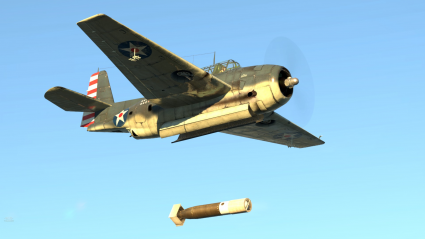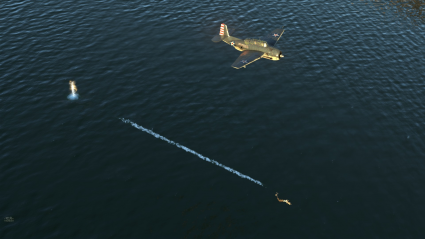22.5-inch Mk.13/44
Contents
Description
The Mk.13-6 Case (2,216 lb) torpedo was a guinea pig of a torpedo having been the subject of testing and modification since 1925. Used early in World War II, this torpedo failed to operate properly approximately 70% of the time with problems of running cold (propeller mechanism failed to start), sinking, not running true (deviating path), improper depth, running on the surface or porposing (continuous jumping out of the water) due to improper water contact. Aircraft were required to fly extremely slow and low when dropping the torpedo as to not damage it on impact with the water and to provide the most stable drop possible, unfortunately, this put the torpedo bomber in a bad position of being an easy target for anti-aircraft guns mounted on enemy ships.
Extensive testing in 1942 determined that the low and slow approach to the Mk.13 launch was actually counterproductive as it caused the torpedo to “belly-flop” on the water resulting in damage sustained to its internal components. New modifications were tested which replaced fragile parts and components which were susceptible to damage upon impact with the water. A new study also implemented the addition of frangible “drag rings” and box-shaped tail stabilizers. These devices served to stabilize the torpedo during higher drops, lower the nose for the initial impact and reduce the depth at which the torpedo dove after impact. The wood drag rings and stabilizers were obliterated on impact with the water which absorbed some of the impact, protecting the torpedo.[1] By 1944 the Mk.13 was essentially a brand new torpedo and was accepted as the best aircraft torpedo in the U.S. inventory at that time and was credited with the sinking of the Japanese battleship Yamato.[2]
Later after World War II, there came a need for river patrol boats to be outfitted with torpedo launchers. The Mk.13 was the ideal torpedo to fulfil this need due to its short stature (compared to other torpedoes) and excelled in a shallow launch and run which afforded it to operate in shallow waters without hitting the bottom. Opportunities for sea use on smaller vessels were available in shallow areas where larger ships and torpedoes could not operate.
Vehicles equipped with this weapon
| Vehicles equipped with this weapon | |
|---|---|
| Fighters | F6F-5 · ▄F6F-5 · F6F-5N · ▄F6F-5N · ▄Hellcat Mk II |
| Attackers | A2D-1 · AD-2 · AD-4 · ▄AD-4 · AM-1 |
| Bombers | ▄Avenger Mk II · B-34 · BTD-1 · PBY-5 Catalina · PBY-5A Catalina · ▄Catalina Mk IIIa · ▂PBY-5A Catalina |
| PV-2D · SB2C-1C · SB2C-4 · ▄SB2C-5 · TBD-1 · TBF-1C | |
General info
The aircraft torpedo Mk.13 is typically carried on attack-type aircraft[1], however, there are a few light bombers which can also be outfitted with them. The design of the Mk.13 departed from conventional torpedo design for submarines and destroyers to accommodate being delivered by aircraft and being dropped.[2] Due to the short and stocky size of the torpedoes, they were also ideal to be outfitted on motor torpedo boats where they could either be launched from tubes or just rolled off the side of the boat for more stealthy approaches.
The appearance of this torpedo is similar to many others in that it has the appearance of a mini-submarine which contains an engine, fuel and steering devices. At almost one ton in weight, 600 lbs of it is the detachable warhead which is filled with the highly explosive Torpex.[1]
The Mk.13 torpedo was specifically designed to be used from an aerial platform with a range of 5.7 km with an in-water speed of almost 67 kph. The Mk.13 designation applies to the entire torpedo assembly as a whole, however, portions of the torpedo (warhead, gyroscope and other sub-assemblies) will have their own mark and mod designations.
Implemented modifications
- Perminant modification
- Shroud Ring: The shroud ring (or “ring tail) is a metal cylindrical band, coaxial with the torpedo and mounted near the rear end of the tail vanes just fore of the propellers. The shroud ring does not provide any help with stability while the torpedo is airborne, however, it does provide a considerable amount of stability for the torpedo while it is in the water. In addition to providing stability in the water, the shroud prevents the torpedo from deep-diving, hooks, water roll or breaching the surface and keeps it on a steady course heading toward its target.[1][2]
- Frangible add-on parts for an aerial drop
- Drag ring: The drag ring ( also known as the “pickle barrel”) which covered the rounded nose of the torpedo and secured with a length of softwood pinning the drag ring into place through the torpedoes nose ring. It was found that the aerodynamics of the torpedo was such that it would oscillate during the fall causing the torpedo to impact and damage the tail section.[2] The drag ring stabilized the torpedoes drop eliminating the oscillations by reducing the aerodynamics, helping keep the nose pointed downwards to breach the surface instead of skipping on the surface. As the drag ring enters the water it breaks apart and falls away, but in the process creates a bubble around the torpedo which helps to absorb the shock of the impact, reducing potential damage to the warhead portion of the torpedo.[1]
- Box stabilizer: A plywood, box-shaped stabilizer has been built around the shroud ring of the torpedo and is held together with wooden pegs which sheer during impact with the water. The wooden stabilizer acts to guide the torpedo to drop in a smooth curve and help the drag ring in pointing the torpedo nose-first into the water. After impact with the water and the box stabilizer has fallen away, the torpedo is free to make a clean run to the target.[1][2]
Effective damage
The Mk.13 torpedo had a large high-explosive warhead compared to the Mk.VII which was frequently used at the time. The Mk.13 had a 600 lb (270 kg) Torpex (Torpedo Explosive) warhead compared the Mk.VII’s 466 lb (211 kg) warhead. Torpex was an explosive which was about 50% more powerful than TNT by mass alone as this mixture contained 40% TNT, 42% RDX and 18% powdered aluminium.[2] While not as fast nor had as long of range as other torpedoes, the Mk.13 was used effectively at night when stealthy operations from PT boats which took place requiring torpedoes to reach the target with the least amount of warning. Aerial operations took advantage of the slower torpedo by dropping it from a higher altitude, increasing its time in the air and getting it closer to the target before it entered the water.[1]
Comparison with analogues
- Mk.13 : This is the same torpedo as the Mk.13-6 Case (2,216 lb), however, it has not been outfitted with the frangible drag ring and box stabilizer to allow for higher drops at faster speeds. The Mk.13 is the culmination of upgrades and modifications prior to the addition of the drag ring and box stabilizer. This version of torpedo requires a lower and slower altitude to be released at than the Mk.13-6 Case (2,216 lb).[1]
Usage in battles
The upgraded Mk.13 torpedo can be utilised against any target which is in the water which can include ships, boats, tanks (at the water's edge), boat-planes or even structures. Due to the higher altitude in which it can be dropped from, the delivering bomber can make a safer approach, release and get-away avoiding ship-board anti-aircraft fire and fighters patrolling around ships.
Pros and cons
Pros:
- Can be dropped from higher altitudes (maximum 820 ft (250 m))
- Can be dropped at higher speeds (maximum 322 mph (518 kph))
- Higher release increases glide distance, decreases time in the water to the target
Cons:
- Aircraft typically only carry one or two at a time
- Slow, given enough distance a ship can avoid the torpedo
History
Describe the history of the creation and combat usage of the weapon in more detail than in the introduction. If the historical reference turns out to be too long, take it to a separate article, taking a link to the article about the weapon and adding a block "/ History" (example: https://wiki.warthunder.com/(Weapon-name)/History) and add a link to it here using the main template. Be sure to reference text and sources by using <ref></ref>, as well as adding them at the end of the article with <references />.
Media
See also
Links to the articles on the War Thunder Wiki that you think will be useful for the reader, for example:
- reference to the article about the variant of the weapon;
- references to approximate analogues by other nations and research trees.
External links
- NavWeaps Website [World War II Torpedoes of the United States]
- Flight Journal Website [Iconic Firepower: The Outstandingly Bad Mark 13 Torpedo]
- Ordnance Pamphlet No. 629(A) [U.S. Navy Torpedoes Mark 13, B-1 & 2 July 1942]
- NAVPERS 10826 [Naval Airborne Ordnance], p. 153-166
References







